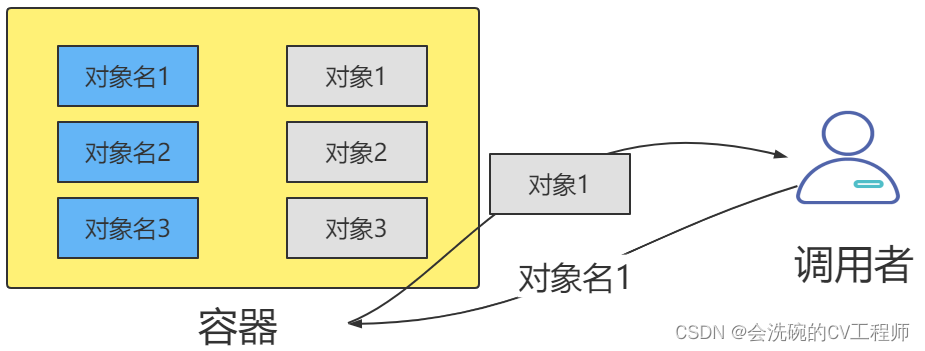目录
相关导读
1. Maven专栏系列文章
2. Mybatis专栏系列文章
3. Spring系列专栏文章
前言
Spring简介
Spring体系结构
一、IOC控制反转思想
二、IOC自定义对象容器
1. 创建实体类,Dao接口,实现类
2. 创建配置文件bean.properties
3. 创建容器管理类
4. 创建StudentService类
5. 测试方法
6. 测试结果
相关导读
大家如果对于本期内容有什么不了解的话也可以去看看往期的内容,下面列出了博主往期精心制作的Maven,Mybatis等专栏系列文章,走过路过不要错过哎!如果对您有所帮助的话就点点赞,收藏一下啪。其中Spring专栏有些正在更,所以无法查看,但是当博主全部更完之后就可以看啦。
1. Maven专栏系列文章
| Maven系列专栏 | Maven工程开发 |
| Maven聚合开发【实例详解---5555字】 |
2. Mybatis专栏系列文章
| Mybatis系列专栏 | MyBatis入门配置 |
| Mybatis入门案例【超详细】 | |
| MyBatis配置文件 —— 相关标签详解 | |
| Mybatis模糊查询——三种定义参数方法和聚合查询、主键回填 | |
| Mybatis动态SQL查询 --(附实战案例--8888个字--88质量分) | |
| Mybatis分页查询——四种传参方式 | |
| Mybatis一级缓存和二级缓存(带测试方法) | |
| Mybatis分解式查询 | |
| Mybatis关联查询【附实战案例】 | |
| MyBatis注解开发---实现增删查改和动态SQL | |
| MyBatis注解开发---实现自定义映射关系和关联查询 |
3. Spring系列专栏文章
| Spring系列专栏 | Spring IOC 入门简介【自定义容器实例】 |
| IOC使用Spring实现附实例详解 | |
| Spring IOC之对象的创建方式、策略及销毁时机和生命周期且获取方式 | |
| Spring DI简介及依赖注入方式和依赖注入类型 | |
| Spring IOC相关注解运用——上篇 | |
| Spring IOC相关注解运用——下篇 | |
| Spring AOP简介及相关案例 | |
| 注解、原生Spring、SchemaBased三种方式实现AOP【附详细案例】 | |
| Spring事务简介及相关案例 | |
| Spring 事务管理方案和事务管理器及事务控制的API | |
| Spring 事务的相关配置、传播行为、隔离级别及注解配置声明式事务 |
前言
Spring简介
Spring是一个开源框架,为简化企业级开发而生。它以IOC(控制反转)和AOP(面向切面)为思想内核,提供了控制层SpringMVC、数据层SpringData、服务层事务管理等众多技术,并可以整合众多第三方框架。Spring将很多复杂的代码变得优雅简洁,有效的降低代码的耦合度,极大的方便项目的后期维护、升级和扩展。
Spring官网地址:https://spring.io/
Spring官方网站:

Spring体系结构
Spring框架根据不同的功能被划分成了多个模块,这些模块可以满足一切企业级应用开发的需求,在开发过程中可以根据需求有选择性地使用所需要的模块。
Core Container:Spring核心模块,任何功能的使用都离不开该模块,是其他模块建立的基础。Data Access/Integration:该模块提供了数据持久化的相应功能。Web:该模块提供了web开发的相应功能。AOP:提供了面向切面编程实现Aspects:提供与AspectJ框架的集成,该框架是一个面向切面编程框架。Instrumentation:提供了类工具的支持和类加载器的实现,可以在特定的应用服务器中使用。Messaging:为Spring框架集成一些基础的报文传送应用Test:提供与测试框架的集成一、IOC控制反转思想
控制反转就是让框架创建对象
IOC(Inversion of Control) :程序将创建对象的权利交给框架。之前在开发过程中,对象实例的创建是由调用者管理的,代码如下:
public interface StudentDao { // 根据id查询学生 Student findById(int id);}public class StudentDaoImpl implements StudentDao{ @Override public Student findById(int id) { // 模拟从数据库查找出学生 return new Student(1,"程序员","北京"); }}public class StudentService { public Student findStudentById(int id){ // 此处就是调用者在创建对象 StudentDao studentDao = newStudentDaoImpl(); return studentDao.findById(1); }}这种写法有两个缺点:
浪费资源:StudentService调用方法时即会创建一个对象,如果不断调用方法则会创建大量StudentDao对象。代码耦合度高:假设随着开发,我们创建了StudentDao另一个更加完善的实现类StudentDaoImpl2,如果在StudentService中想使用StudentDaoImpl2,则必须修改源码。而IOC思想是将创建对象的权利交给框架,框架会帮助我们创建对象,分配对象的使用,控制权由程序代码转移到了框架中,控制权发生了反转,这就是Spring的IOC思想。而IOC思想可以完美的解决以上两个问题。
二、IOC自定义对象容器

接下来我们通过一段代码模拟IOC思想。创建一个集合容器,先将对象创建出来放到容器中,需要使用对象时,只需要从容器中获取对象即可,而不需要重新创建,此时容器就是对象的管理者。
1. 创建实体类,Dao接口,实现类
Student实体类
package com.example.pojo;public class Student { private int id; private String name; private String address; public Student(int id, String name, String address) { this.id = id; this.name = name; this.address = address; } public Student(){} public int getId() { return id; } public void setId(int id) { this.id = id; } public String getName() { return name; } public void setName(String name) { this.name = name; } public String getAddress() { return address; } public void setAddress(String address) { this.address = address; } @Override public String toString() { return "Student[ " + "id=" + id + ", name='" + name + '\'' + ", address='" + address + '\'' + " ]"; }}StudentDao接口
package com.example.dao;import com.example.pojo.Student;public interface StudentDao { // 根据id查询学生 Student findById(int id);}StudentDao接口实现类1:StudentDaoImpl1
package com.example.dao;import com.example.pojo.Student;public class StudentDaoImpl1 implements StudentDao{ public StudentDaoImpl1() { } public StudentDaoImpl1(int a){}; @Override public Student findById(int id){ return new Student(id,"程序员","北京"); }}StudentDao接口实现类1:StudentDaoImpl2
package com.example.dao;import com.example.pojo.Student;public class StudentDaoImpl2 implements StudentDao{ @Override public Student findById(int id) { // 模拟根据ID查询学生 System.out.println("新方法!!!"); return new Student(id,"程序员","上海"); }}2. 创建配置文件bean.properties
该文件中定义管理的对象
studentDao=com.example.dao.StudentDaoImpl23. 创建容器管理类
package com.example;import java.io.InputStream;import java.util.Enumeration;import java.util.HashMap;import java.util.Map;import java.util.Properties;public class Container { static Map<String,Object> map = new HashMap<>(); static { // 读取配置文件 InputStream is = Container.class.getClassLoader().getResourceAsStream("bean.properties"); Properties properties = new Properties(); try{ properties.load(is); }catch (Exception e){ e.printStackTrace(); } // 遍历配置文件的所有配置 Enumeration<Object> keys = properties.keys(); while(keys.hasMoreElements()){ String key = keys.nextElement().toString(); String value = properties.getProperty(key); try{ Object o = Class.forName(value).newInstance(); map.put(key,o); }catch (Exception e){ e.printStackTrace(); } } } // 从容器中获取对象 public static Object getBean(String key){ return map.get(key); }}4. 创建StudentService类
package com.example.service;import com.example.Container;import com.example.dao.StudentDao;import com.example.domain.Student;public class StudentService { public Student findStudentById(int id){ // 从容器中获取对象 StudentDao studentDao = (StudentDao) Container.getBean("studentDao"); System.out.println(studentDao.hashCode()); return studentDao.findById(id); }}5. 测试方法
package com.example.test;import com.example.Container;import com.example.service.StudentService;public class Test { public static void main(String[] args) { StudentService studentService = new StudentService(); System.out.println(studentService.findStudentById(1)); System.out.println(studentService.findStudentById(1)); }}6. 测试结果

StudentService从容器中每次拿到的都是同一个StudentDao对象,节约了资源。
如果想使用StudentDaoImpl2对象,只需要修改bean.properties的内容为:
studentDao=com.itbaizhan.dao.StudentDaoImpl2即可,无需修改Java源码。
或者如果不想new StudentService,也可以在bean.properties加上一行:
studentService = com.example.service.StudentService